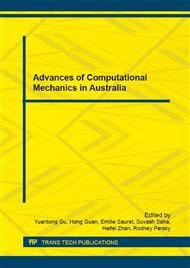p.79
p.85
p.91
p.96
p.102
p.108
p.114
p.120
p.127
Numerical Investigation on Fracturing of Rock under Blast Using Coupled Finite Element Method and Smoothed Particle Hydrodynamics
Abstract:
This paper aims to provide a coupled finite element method (FEM) and smoothed particle hydrodynamics (SPH) approach capable of reproducing the blast response in rock. In the proposed approach, SPH is used to simulate large deformation and fracture of rock at the near detonation zone, while the FEM is adopted to capture the far field response of the rock. The explosive is modelled explicitly using SPH. The numerical simulations are carried out using LS-DYNA. The interaction of the SPH particles and FEM elements was modelled by the node to surface contact, and for the interactions between explosive and rock SPH parts node to node penalty based contact was used. In the present study, the Johnson and Holmquist constitutive model is used for rock. Jones–Wilkins–Lee model is used for TNT explosive. It is found that the preliminary numerical simulation reproduces some of the well-known phenomena observed experimentally by other researchers. The numerical results indicate that the coupled SPH-FEM approach used in this work can be applied to simulate effectively both compressive and tensile damage of rock subjected to blast loading.
Info:
Periodical:
Pages:
102-107
Citation:
Online since:
July 2016
Authors:
Keywords:
Price:
Сopyright:
© 2016 Trans Tech Publications Ltd. All Rights Reserved
Share:
Citation:


